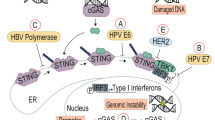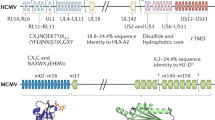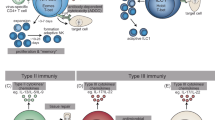Abstract
In addition to the conventional innate and acquired immune responses, complex organisms have evolved an array of dominant, constitutively expressed genes that suppress or prevent viral infections. Two major cellular defenses against infection by retroviruses are the Fv1 and TRIM5 class of inhibitors that target incoming retroviral capsids and the APOBEC3 class of cytidine deaminases that hypermutate and destabilize retroviral genomes. Additional, less well characterized activities also inhibit viral replication. Here, the present understanding of these 'intrinsic' immune mechanisms is reviewed and their role in protection from retroviral infection is discussed.
This is a preview of subscription content, access via your institution
Access options
Subscribe to this journal
Receive 12 print issues and online access
$209.00 per year
only $17.42 per issue
Buy this article
- Purchase on Springer Link
- Instant access to full article PDF
Prices may be subject to local taxes which are calculated during checkout


Similar content being viewed by others
References
Sommerfelt, M.A. & Weiss, R.A. Receptor interference groups of 20 retroviruses plating on human cells. Virology 176, 58–69 (1990).
Miller, A.D. & Wolgamot, G. Murine retroviruses use at least six different receptors for entry into Mus dunni cells. J. Virol. 71, 4531–4535 (1997).
Ikeda, H. & Sugimura, H. Fv-4 resistance gene: a truncated endogenous murine leukemia virus with ecotropic interference properties. J. Virol. 63, 5405–5412 (1989).
Mura, M. et al. Late viral interference induced by transdominant Gag of an endogenous retrovirus. Proc. Natl. Acad. Sci. USA 101, 11117–11122 (2004).
Odaka, T. & Yamamoto, T. Inheritance of susceptibility to Friend mouse leukemia virus. 11. Spleen foci method applied to test the susceptibility of crossbred progeny between a sensitive and a resistant strain. Jpn. J. Exp. Med. 35, 311–314 (1965).
Lilly, F. Susceptibility to two strains of Friend leukemia virus in mice. Science 155, 461–462 (1967).
Suzuki, S. FV-4: a new gene affecting the splenomegaly induction by Friend leukemia virus. Jpn. J. Exp. Med. 45, 473–478 (1975).
Gardner, M.B., Rasheed, S., Pal, B.K., Estes, J.D. & O'Brien, S.J. Akvr-1, a dominant murine leukemia virus restriction gene, is polymorphic in leukemia-prone wild mice. Proc. Natl. Acad. Sci. USA 77, 531–535 (1980).
Rasheed, S. & Gardner, M.B. Resistance to fibroblasts and hematopoietic cells to ecotropic murine leukemia virus infection; an Akvr-1R gene effect. Int. J. Cancer 31, 491–496 (1983).
Hartley, J.W., Rowe, W.P. & Huebner, R.J. Host-range restrictions of murine leukemia viruses in mouse embryo cell cultures. J. Virol. 5, 221–225 (1970).
Pincus, T., Hartley, J.W. & Rowe, W.P. A major genetic locus affecting resistance to infection with murine leukemia viruses. I. Tissue culture studies of naturally occurring viruses. J. Exp. Med. 133, 1219–1233 (1971).
Rowe, W.P. Studies of genetic transmission of murine leukemia virus by AKR mice. I. Crosses with Fv-1 n strains of mice. J. Exp. Med. 136, 1272–1285 (1972).
Rowe, W.P. & Hartley, J.W. Studies of genetic transmission of murine leukemia virus by AKR mice. II. Crosses with Fv-1 b strains of mice. J. Exp. Med. 136, 1286–1301 (1972).
Kozak, C.A. Analysis of wild-derived mice for Fv-1 and Fv-2 murine leukemia virus restriction loci: a novel wild mouse Fv-1 allele responsible for lack of host range restriction. J. Virol. 55, 281–285 (1985).
DesGroseillers, L. & Jolicoeur, P. Physical mapping of the Fv-1 tropism host range determinant of BALB/c murine leukemia viruses. J. Virol. 48, 685–696 (1983).
Kozak, C.A. & Chakraborti, A. Single amino acid changes in the murine leukemia virus capsid protein gene define the target of Fv1 resistance. Virology 225, 300–305 (1996).
Decleve, A., Niwa, O., Gelmann, E. & Kaplan, H.S. Replication kinetics of N- and B-tropic murine leukemia viruses on permissive and nonpermissive cells in vitro. Virology 65, 320–332 (1975).
Duran-Troise, G., Bassin, R.H., Rein, A. & Gerwin, B.I. Loss of Fv-1 restriction in Balb/3T3 cells following infection with a single N tropic murine leukemia virus particle. Cell 10, 479–488 (1977).
Pincus, T., Hartley, J.W. & Rowe, W.P. A major genetic locus affecting resistance to infection with murine leukemia viruses. IV. Dose-response relationships in Fv-1-sensitive and resistant cell cultures. Virology 65, 333–342 (1975).
Tennant, R.W., Otten, J.A., Brown, A., Yang, W.K. & Kennel, S.J. Characterization of Fv-1 host range strains of murine retroviruses by titration and p30 protein characteristics. Virology 99, 349–357 (1979).
Boone, L.R., Innes, C.L. & Heitman, C.K. Abrogation of Fv-1 restriction by genome-deficient virions produced by a retrovirus packaging cell line. J. Virol. 64, 3376–3381 (1990).
Bassin, R.H., Duran-Troise, G., Gerwin, B.I. & Rein, A. Abrogation of Fv-1b restriction with murine leukemia viruses inactivated by heat or by gamma irradiation. J. Virol. 26, 306–315 (1978).
Best, S., Le Tissier, P., Towers, G. & Stoye, J.P. Positional cloning of the mouse retrovirus restriction gene Fv1. Nature 382, 826–829 (1996).
Taylor, W.R. & Stoye, J.P. Consensus structural models for the amino terminal domain of the retrovirus restriction gene Fv1 and the murine leukaemia virus capsid proteins. BMC Struct. Biol. 4, 1 (2004).
Ganser, B.K., Cheng, A., Sundquist, W.I. & Yeager, M. Three-dimensional structure of the M-MuLV CA protein on a lipid monolayer: a general model for retroviral capsid assembly. EMBO J. 22, 2886–2892 (2003).
Bock, M., Bishop, K.N., Towers, G. & Stoye, J.P. Use of a transient assay for studying the genetic determinants of Fv1 restriction. J. Virol. 74, 7422–7430 (2000).
Bishop, K.N., Bock, M., Towers, G. & Stoye, J.P. Identification of the regions of Fv1 necessary for murine leukemia virus restriction. J. Virol. 75, 5182–5188 (2001).
Towers, G. et al. A conserved mechanism of retrovirus restriction in mammals. Proc. Natl. Acad. Sci. USA 97, 12295–12299 (2000).
Cowan, S. et al. Cellular inhibitors with Fv1-like activity restrict human and simian immunodeficiency virus tropism. Proc. Natl. Acad. Sci. USA 99, 11914–11919 (2002).
Besnier, C., Takeuchi, Y. & Towers, G. Restriction of lentivirus in monkeys. Proc. Natl. Acad. Sci. USA 99, 11920–11925 (2002).
Munk, C., Brandt, S.M., Lucero, G. & Landau, N.R. A dominant block to HIV-1 replication at reverse transcription in simian cells. Proc. Natl. Acad. Sci. USA 99, 13843–13848 (2002).
Hofmann, W. et al. Species-specific, postentry barriers to primate immunodeficiency virus infection. J. Virol. 73, 10020–10028 (1999).
Owens, C.M., Yang, P.C., Gottlinger, H. & Sodroski, J. Human and simian immunodeficiency virus capsid proteins are major viral determinants of early, postentry replication blocks in simian cells. J. Virol. 77, 726–731 (2003).
Dorfman, T. & Gottlinger, H.G. The human immunodeficiency virus type 1 capsid p2 domain confers sensitivity to the cyclophilin-binding drug SDZ NIM 811. J. Virol. 70, 5751–5757 (1996).
Hatziioannou, T., Cowan, S., Goff, S.P., Bieniasz, P.D. & Towers, G. Restriction of multiple divergent retroviruses by Lv1 and Ref1. EMBO J. 22, 385–94 (2003).
Stremlau, M. et al. The cytoplasmic body component TRIM5α restricts HIV-1 infection in Old World monkeys. Nature 427, 848–853 (2004).
Reymond, A. et al. The tripartite motif family identifies cell compartments. EMBO J. 20, 2140–2151 (2001).
Hatziioannou, T., Perez-Caballero, D., Yang, A., Cowan, S. & Bieniasz, P.D. Retrovirus resistance factors Ref1 and Lv1 are species-specific variants of TRIM5α. Proc. Natl. Acad. Sci. USA 101, 10774–10779 (2004).
Keckesova, Z., Ylinen, L.M. & Towers, G.J. The human and African green monkey TRIM5alpha genes encode Ref1 and Lv1 retroviral restriction factor activities. Proc. Natl. Acad. Sci. USA 101, 10780–10785 (2004).
Perron, M.J. et al. TRIM5α mediates the postentry block to N-tropic murine leukemia viruses in human cells. Proc. Natl. Acad. Sci. USA 101, 11827–11832 (2004).
Sayah, D.M., Sokolskaja, E., Berthoux, L. & Luban, J. Cyclophilin A retrotransposition into TRIM5 explains owl monkey resistance to HIV-1. Nature 430, 569–573 (2004).
Towers, G.J. et al. Cyclophilin A modulates the sensitivity of HIV-1 to host restriction factors. Nat. Med. 9, 1138–1143 (2003).
von Schwedler, U.K. et al. Proteolytic refolding of the HIV-1 capsid protein amino-terminus facilitates viral core assembly. EMBO J. 17, 1555–1568 (1998).
Ganser, B.K., Li, S., Klishko, V.Y., Finch, J.T. & Sundquist, W.I. Assembly and analysis of conical models for the HIV-1 core. Science 283, 80–83 (1999).
Luban, J., Bossolt, K.L., Franke, E.K., Kalpana, G.V. & Goff, S.P. Human immunodeficiency virus type 1 Gag protein binds to cyclophilins A and B. Cell 73, 1067–1078 (1993).
Yap, M.W. & Stoye, J.P. Intracellular localisation of Fv1. Virology 307, 76–89 (2003).
Xu, L. et al. BTBD1 and BTBD2 colocalize to cytoplasmic bodies with the RBCC/tripartite motif protein, TRIM5delta. Exp. Cell Res. 288, 84–93 (2003).
Schwartz, O., Marechal, V., Friguet, B., Arenzana-Seisdedos, F. & Heard, J.M. Antiviral activity of the proteasome on incoming human immunodeficiency virus type 1. J. Virol. 72, 3845–3850 (1998).
Butler, S.L., Johnson, E.P. & Bushman, F.D. Human immunodeficiency virus cDNA metabolism: notable stability of two-long terminal repeat circles. J. Virol. 76, 3739–3747 (2002).
Hicke, L. A new ticket for entry into budding vesicles-ubiquitin. Cell 106, 527–530 (2001).
Pryciak, P.M. & Varmus, H.E. Fv-1 restriction and its effects on murine leukemia virus integration in vivo and in vitro. J. Virol. 66, 5959–5966 (1992).
Gabuzda, D.H. et al. Role of vif in replication of human immunodeficiency virus type 1 in CD4+ T lymphocytes. J. Virol. 66, 6489–6495 (1992).
Madani, N. & Kabat, D. An endogenous inhibitor of human immunodeficiency virus in human lymphocytes is overcome by the viral Vif protein. J. Virol. 72, 10251–10255 (1998).
Simon, J.H., Gaddis, N.C., Fouchier, R.A. & Malim, M.H. Evidence for a newly discovered cellular anti-HIV-1 phenotype. Nat. Med. 4, 1397–1400 (1998).
Sheehy, A.M., Gaddis, N.C., Choi, J.D. & Malim, M.H. Isolation of a human gene that inhibits HIV-1 infection and is suppressed by the viral Vif protein. Nature 418, 646–650 (2002).
Mangeat, B. et al. Broad antiretroviral defence by human APOBEC3G through lethal editing of nascent reverse transcripts. Nature 424, 99–103 (2003).
Zhang, H. et al. The cytidine deaminase CEM15 induces hypermutation in newly synthesized HIV-1 DNA. Nature 424, 94–98 (2003).
Harris, R.S. et al. DNA deamination mediates innate immunity to retroviral infection. Cell 113, 803–809 (2003).
Lecossier, D., Bouchonnet, F., Clavel, F. & Hance, A.J. Hypermutation of HIV-1 DNA in the absence of the Vif protein. Science 300, 1112 (2003).
Yu, Q. et al. Single-strand specificity of APOBEC3G accounts for minus-strand deamination of the HIV genome. Nat. Struct. Mol. Biol. 11, 435–442 (2004).
Sleigh, R., Sharkey, M., Newman, M.A., Hahn, B. & Stevenson, M. Differential association of uracil DNA glycosylase with SIVSM Vpr and Vpx proteins. Virology 245, 338–343 (1998).
Bouhamdan, M. et al. Human immunodeficiency virus type 1 Vpr protein binds to the uracil DNA glycosylase DNA repair enzyme. J. Virol. 70, 697–704 (1996).
Selig, L. et al. Uracil DNA glycosylase specifically interacts with Vpr of both human immunodeficiency virus type 1 and simian immunodeficiency virus of sooty mangabeys, but binding does not correlate with cell cycle arrest. J. Virol. 71, 4842–4846 (1997).
Willetts, K.E. et al. DNA repair enzyme uracil DNA glycosylase is specifically incorporated into human immunodeficiency virus type 1 viral particles through a Vpr-independent mechanism. J. Virol. 73, 1682–1688 (1999).
Mansky, L.M., Preveral, S., Selig, L., Benarous, R. & Benichou, S. The interaction of vpr with uracil DNA glycosylase modulates the human immunodeficiency virus type 1 In vivo mutation rate. J. Virol. 74, 7039–7047 (2000).
Jarmuz, A. et al. An anthropoid-specific locus of orphan C to U RNA-editing enzymes on chromosome 22. Genomics 79, 285–296 (2002).
Wiegand, H.L., Doehle, B.P., Bogerd, H.P. & Cullen, B.R. A second human antiretroviral factor, APOBEC3F, is suppressed by the HIV-1 and HIV-2 Vif proteins. EMBO J. 23, 2451–2458 (2004).
Zheng, Y.H. et al. Human APOBEC3F is another host factor that blocks human immunodeficiency virus type 1 replication. J. Virol. 78, 6073–6076 (2004).
Bishop, K.N. et al. Cytidine deamination of retroviral DNA by diverse APOBEC proteins. Curr. Biol. 14, 1392–1396 (2004).
Liddament, M.T., Brown, W.L., Schumacher, A.J. & Harris, R.S. APOBEC3F properties and hypermutation preferences indicate activity against HIV-1 in vivo. Curr Biol 14, 1385–1391 (2004).
Yu, X. et al. Induction of APOBEC3G ubiquitination and degradation by an HIV-1 Vif-Cul5-SCF complex. Science 302, 1056–1060 (2003).
Sheehy, A.M., Gaddis, N.C. & Malim, M.H. The antiretroviral enzyme APOBEC3G is degraded by the proteasome in response to HIV-1 Vif. Nat. Med. 9, 1404–1407 (2003).
Marin, M., Rose, K.M., Kozak, S.L. & Kabat, D. HIV-1 Vif protein binds the editing enzyme APOBEC3G and induces its degradation. Nat. Med. 9, 1398–1403 (2003).
Mehle, A. et al. Vif overcomes the innate antiviral activity of APOBEC3G by promoting its degradation in the ubiquitin-proteasome pathway. J. Biol. Chem. 279, 7792–7798 (2003).
Conticello, S.G., Harris, R.S. & Neuberger, M.S. The Vif protein of HIV triggers degradation of the human antiretroviral DNA deaminase APOBEC3G. Curr. Biol. 13, 2009–2013 (2003).
Stopak, K., de Noronha, C., Yonemoto, W. & Greene, W.C. HIV-1 Vif blocks the antiviral activity of APOBEC3G by impairing both its translation and intracellular stability. Mol. Cell 12, 591–601 (2003).
Mariani, R. et al. Species-specific exclusion of APOBEC3G from HIV-1 virions by Vif. Cell 114, 21–31 (2003).
Turelli, P., Mangeat, B., Jost, S., Vianin, S. & Trono, D. Inhibition of hepatitis B virus replication by APOBEC3G. Science 303, 1829 (2004).
Ngui, S.L., Hallet, R. & Teo, C.G. Natural and iatrogenic variation in hepatitis B virus. Rev. Med. Virol. 9, 183–209 (1999).
Machida, K. et al. Hepatitis C virus induces a mutator phenotype: enhanced mutations of immunoglobulin and protooncogenes. Proc. Natl. Acad. Sci. USA 101, 4262–4267 (2004).
Bishop, K.N., Holmes, R.K., Sheehy, A.M. & Malim, M.H. APOBEC-mediated editing of viral RNA. Science 305, 645 (2004).
Gao, G., Guo, X. & Goff, S.P. Inhibition of retroviral RNA production by ZAP a CCCH-type zinc finger protein. Science 297, 1703–1706 (2002).
Bick, M.J. et al. Expression of the zinc-finger antiviral protein inhibits alphavirus replication. J. Virol. 77, 11555–11562 (2003).
Varthakavi, V., Smith, R.M., Bour, S.P., Strebel, K. & Spearman, P. Viral protein U counteracts a human host cell restriction that inhibits HIV-1 particle production. Proc. Natl. Acad. Sci. USA 100, 15154–15159 (2003).
Gottlinger, H.G., Dorfman, T., Cohen, E.A. & Haseltine, W.A. Vpu protein of human immunodeficiency virus type 1 enhances the release of capsids produced by gag gene constructs of widely divergent retroviruses. Proc. Natl. Acad. Sci. USA 90, 7381–7385 (1993).
Geraghty, R.J., Talbot, K.J., Callahan, M., Harper, W. & Panganiban, A.T. Cell type-dependence for Vpu function. J. Med. Primatol. 23, 146–150 (1994).
Sakai, H., Tokunaga, K., Kawamura, M. & Adachi, A. Function of human immunodeficiency virus type 1 Vpu protein in various cell types. J. Gen. Virol. 76, 2717–2722 (1995).
Turelli, P. et al. Cytoplasmic recruitment of INI1 and PML on incoming HIV preintegration complexes: interference with early steps of viral replication. Mol. Cell 7, 1245–1254 (2001).
Yap, M.W., Nisole, S., Lynch, C. & Stoye, J.P. Trim5α protein restricts both HIV-1 and murine leukemia virus. Proc. Natl. Acad. Sci. USA 101, 10786–10791 (2004).
Berthoux, L. et al. As2O3 enhances retroviral reverse transcription and counteracts Ref1 antiviral activity. J. Virol. 77, 3167–3180 (2003).
Bogerd, H.P., Doehle, B.P., Wiegand, H.L. & Cullen, B.R. A single amino acid difference in the host APOBEC3G protein controls the primate species specificity of HIV type 1 virion infectivity factor. Proc. Natl. Acad. Sci. USA 101, 3770–3774 (2004).
Schrofelbauer, B., Chen, D. & Landau, N.R. A single amino acid of APOBEC3G controls its species-specific interaction with virion infectivity factor (Vif). Proc. Natl. Acad. Sci. USA 101, 3927–3932 (2004).
Mangeat, B., Turelli, P., Liao, S. & Trono, D. A single amino acid determinant governs the species-specific sensitivity of APOBEC3G to Vif action. J. Biol. Chem. 279, 14481–14483 (2004).
Xu, H. et al. A single amino acid substitution in human APOBEC3G antiretroviral enzyme confers resistance to HIV-1 virion infectivity factor-induced depletion. Proc. Natl. Acad. Sci. USA 101, 5652–5657 (2004).
Svarovskaia, E.S. et al. Human APOBEC3G is incorporated into HIV-1 virions through interactions with viral and nonviral RNAs. J. Biol. Chem. 279, 35822–35828 (2004).
Cen, S. et al. The interaction between HIV-1 Gag and APOBEC3G. J. Biol. Chem. 279, 33177–33184 (2004).
Alce, T.M. & Popik, W. APOBEC3G is incorporated into virus-like particles by a direct interaction with HIV-1 Gag nucleocapsid protein. 279, 34083–34086 J. Biol. Chem. (2004).
Zennou, V., Perez-Caballero, D. & Bieniasz, P.D. APOBEC3G incorporation into HIV-1 particles J. Virology (in the press).
Schafer, A., Bogerd, H.P. & Cullen, B.R. Specific packaging of APOBEC3G into HIV-1 Virions is mediated by the nucleocapsid domain of the Gag polyprotein precursor. Virology (in the press).
Kobayashi, M. et al. APOBEC3G targets specific virus species. J. Virol. 78, 8238–8244 (2004).
Janeway, C.A. Jr. & Medzhitov, R. Innate immune recognition. Annu. Rev. Immunol. 20, 197–216 (2002).
Acknowledgements
I thank T. Hatziioannou for comments on the manuscript; and B. Cullen, M. Malim and M. Palmarini for sharing manuscripts before publication. Supported by the National Institutes of Health, the American Foundation for AIDS Research, GlaxoSmithKline.
Author information
Authors and Affiliations
Corresponding author
Ethics declarations
Competing interests
The author declares no competing financial interests.
Rights and permissions
About this article
Cite this article
Bieniasz, P. Intrinsic immunity: a front-line defense against viral attack. Nat Immunol 5, 1109–1115 (2004). https://doi.org/10.1038/ni1125
Published:
Issue Date:
DOI: https://doi.org/10.1038/ni1125
This article is cited by
-
Lessons in self-defence: inhibition of virus entry by intrinsic immunity
Nature Reviews Immunology (2022)
-
Restriction factors in human retrovirus infections and the unprecedented case of CIITA as link of intrinsic and adaptive immunity against HTLV-1
Retrovirology (2019)
-
Utilization of different anti‐viral mechanisms by mammalian embryonic stem cells and differentiated cells
Immunology & Cell Biology (2017)
-
Trans-species polymorphism in humans and the great apes is generally maintained by balancing selection that modulates the host immune response
Human Genomics (2015)



